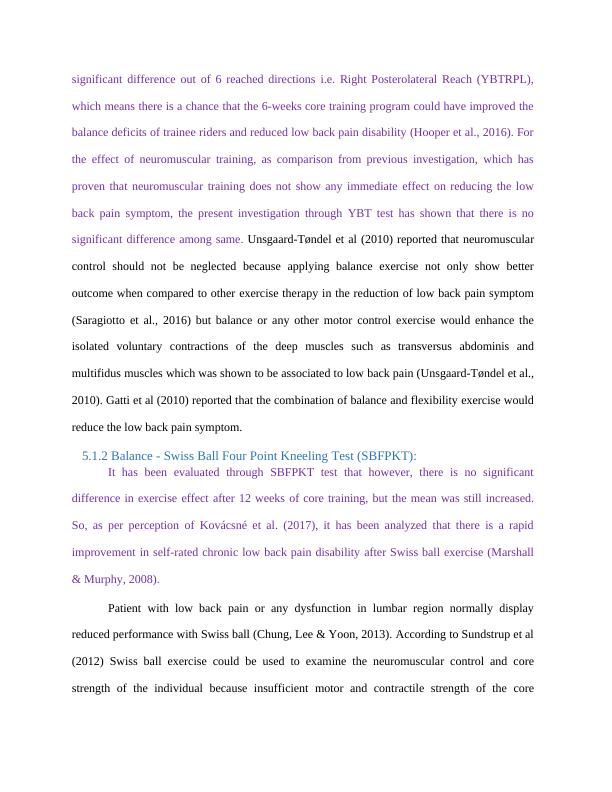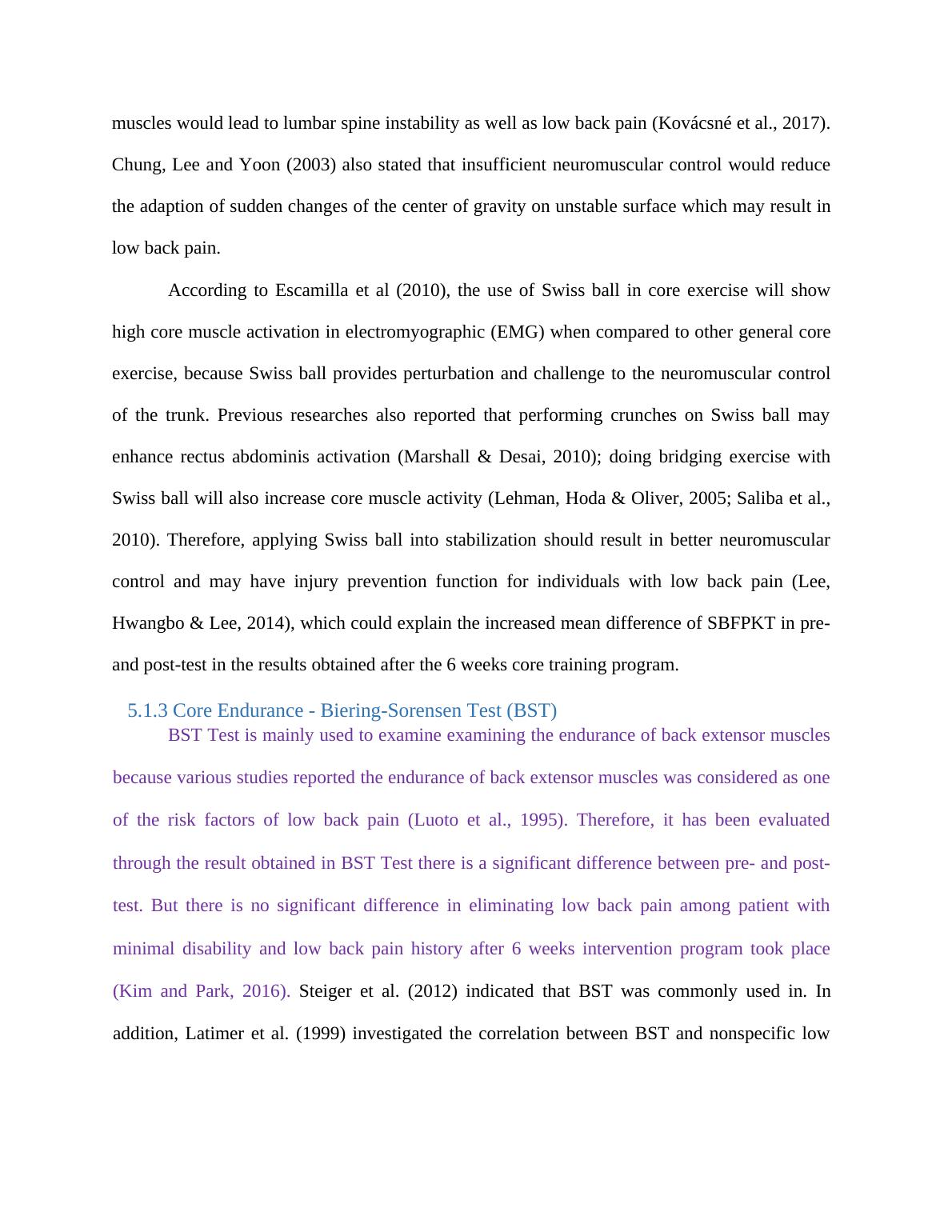Efficacy of 6 Week Core Training Program for Balance, Core Endurance, and Low Back Pain
Added on 2023-02-01
10 Pages3082 Words90 Views
Chapter 5. Discussion
This study aims to investigate the efficacy of the 6 week core training program: the
relationship between balance, core endurance and low back pain based on dynamic balance of
lower limb (Y-Balance Test), core stability on unstable surface (Swiss Ball Four Point Kneeling
Test) and static core endurance (Biering-Sorensen Test, Prone Bridge, Right Side Bridge & Left
Side Bridge) in trainee riders from Hong Kong Jockey Club. In order to investigate the given
study and analyze the outcomes of 6-weeks training program IBM SPSS statistical Base 24.0
software has been used by researchers. This statistical test provided more effective and reliable
information that helps in checking viability of result. Here, data has been expressed as mean ±
standard deviation (SD), where main purposes of conducting statistical analysis was two test the
viability on the basis of pre-test and post-test.
5.1.1 Balance - Y-Balance Test (YBT):
There are various studies investigating the correlation between low back pain and
neuromuscular control of the lumbar spine (Soomro and et. al., 2016). However, there has not
been many researches evaluating the effectiveness of neuromuscular training among low back
pain population. In this regard, in order to measure the effectiveness of training proprioceptive
training on agility in Hong Kong national first-team cricket players YBT test has been used by
project team of present study. It is a dynamic balance test which requires neuromuscular
control, previous research indicated that YBT is highly reliable in assessing dynamic balance of
an individual (Plisky et al., 2009). Hooper et al (2016) reported that subject with low back pain
history would have reduced performance in posteromedial reach and posterolateral reach in
YBT.
After 6-weeks core training program with the trainee riders, it has been evaluated
through statistical analysis that the results obtained through YBT Test showed there was only 1
This study aims to investigate the efficacy of the 6 week core training program: the
relationship between balance, core endurance and low back pain based on dynamic balance of
lower limb (Y-Balance Test), core stability on unstable surface (Swiss Ball Four Point Kneeling
Test) and static core endurance (Biering-Sorensen Test, Prone Bridge, Right Side Bridge & Left
Side Bridge) in trainee riders from Hong Kong Jockey Club. In order to investigate the given
study and analyze the outcomes of 6-weeks training program IBM SPSS statistical Base 24.0
software has been used by researchers. This statistical test provided more effective and reliable
information that helps in checking viability of result. Here, data has been expressed as mean ±
standard deviation (SD), where main purposes of conducting statistical analysis was two test the
viability on the basis of pre-test and post-test.
5.1.1 Balance - Y-Balance Test (YBT):
There are various studies investigating the correlation between low back pain and
neuromuscular control of the lumbar spine (Soomro and et. al., 2016). However, there has not
been many researches evaluating the effectiveness of neuromuscular training among low back
pain population. In this regard, in order to measure the effectiveness of training proprioceptive
training on agility in Hong Kong national first-team cricket players YBT test has been used by
project team of present study. It is a dynamic balance test which requires neuromuscular
control, previous research indicated that YBT is highly reliable in assessing dynamic balance of
an individual (Plisky et al., 2009). Hooper et al (2016) reported that subject with low back pain
history would have reduced performance in posteromedial reach and posterolateral reach in
YBT.
After 6-weeks core training program with the trainee riders, it has been evaluated
through statistical analysis that the results obtained through YBT Test showed there was only 1

significant difference out of 6 reached directions i.e. Right Posterolateral Reach (YBTRPL),
which means there is a chance that the 6-weeks core training program could have improved the
balance deficits of trainee riders and reduced low back pain disability (Hooper et al., 2016). For
the effect of neuromuscular training, as comparison from previous investigation, which has
proven that neuromuscular training does not show any immediate effect on reducing the low
back pain symptom, the present investigation through YBT test has shown that there is no
significant difference among same. Unsgaard-Tøndel et al (2010) reported that neuromuscular
control should not be neglected because applying balance exercise not only show better
outcome when compared to other exercise therapy in the reduction of low back pain symptom
(Saragiotto et al., 2016) but balance or any other motor control exercise would enhance the
isolated voluntary contractions of the deep muscles such as transversus abdominis and
multifidus muscles which was shown to be associated to low back pain (Unsgaard-Tøndel et al.,
2010). Gatti et al (2010) reported that the combination of balance and flexibility exercise would
reduce the low back pain symptom.
5.1.2 Balance - Swiss Ball Four Point Kneeling Test (SBFPKT):
It has been evaluated through SBFPKT test that however, there is no significant
difference in exercise effect after 12 weeks of core training, but the mean was still increased.
So, as per perception of Kovácsné et al. (2017), it has been analyzed that there is a rapid
improvement in self-rated chronic low back pain disability after Swiss ball exercise (Marshall
& Murphy, 2008).
Patient with low back pain or any dysfunction in lumbar region normally display
reduced performance with Swiss ball (Chung, Lee & Yoon, 2013). According to Sundstrup et al
(2012) Swiss ball exercise could be used to examine the neuromuscular control and core
strength of the individual because insufficient motor and contractile strength of the core
which means there is a chance that the 6-weeks core training program could have improved the
balance deficits of trainee riders and reduced low back pain disability (Hooper et al., 2016). For
the effect of neuromuscular training, as comparison from previous investigation, which has
proven that neuromuscular training does not show any immediate effect on reducing the low
back pain symptom, the present investigation through YBT test has shown that there is no
significant difference among same. Unsgaard-Tøndel et al (2010) reported that neuromuscular
control should not be neglected because applying balance exercise not only show better
outcome when compared to other exercise therapy in the reduction of low back pain symptom
(Saragiotto et al., 2016) but balance or any other motor control exercise would enhance the
isolated voluntary contractions of the deep muscles such as transversus abdominis and
multifidus muscles which was shown to be associated to low back pain (Unsgaard-Tøndel et al.,
2010). Gatti et al (2010) reported that the combination of balance and flexibility exercise would
reduce the low back pain symptom.
5.1.2 Balance - Swiss Ball Four Point Kneeling Test (SBFPKT):
It has been evaluated through SBFPKT test that however, there is no significant
difference in exercise effect after 12 weeks of core training, but the mean was still increased.
So, as per perception of Kovácsné et al. (2017), it has been analyzed that there is a rapid
improvement in self-rated chronic low back pain disability after Swiss ball exercise (Marshall
& Murphy, 2008).
Patient with low back pain or any dysfunction in lumbar region normally display
reduced performance with Swiss ball (Chung, Lee & Yoon, 2013). According to Sundstrup et al
(2012) Swiss ball exercise could be used to examine the neuromuscular control and core
strength of the individual because insufficient motor and contractile strength of the core

muscles would lead to lumbar spine instability as well as low back pain (Kovácsné et al., 2017).
Chung, Lee and Yoon (2003) also stated that insufficient neuromuscular control would reduce
the adaption of sudden changes of the center of gravity on unstable surface which may result in
low back pain.
According to Escamilla et al (2010), the use of Swiss ball in core exercise will show
high core muscle activation in electromyographic (EMG) when compared to other general core
exercise, because Swiss ball provides perturbation and challenge to the neuromuscular control
of the trunk. Previous researches also reported that performing crunches on Swiss ball may
enhance rectus abdominis activation (Marshall & Desai, 2010); doing bridging exercise with
Swiss ball will also increase core muscle activity (Lehman, Hoda & Oliver, 2005; Saliba et al.,
2010). Therefore, applying Swiss ball into stabilization should result in better neuromuscular
control and may have injury prevention function for individuals with low back pain (Lee,
Hwangbo & Lee, 2014), which could explain the increased mean difference of SBFPKT in pre-
and post-test in the results obtained after the 6 weeks core training program.
5.1.3 Core Endurance - Biering-Sorensen Test (BST)
BST Test is mainly used to examine examining the endurance of back extensor muscles
because various studies reported the endurance of back extensor muscles was considered as one
of the risk factors of low back pain (Luoto et al., 1995). Therefore, it has been evaluated
through the result obtained in BST Test there is a significant difference between pre- and post-
test. But there is no significant difference in eliminating low back pain among patient with
minimal disability and low back pain history after 6 weeks intervention program took place
(Kim and Park, 2016). Steiger et al. (2012) indicated that BST was commonly used in. In
addition, Latimer et al. (1999) investigated the correlation between BST and nonspecific low
Chung, Lee and Yoon (2003) also stated that insufficient neuromuscular control would reduce
the adaption of sudden changes of the center of gravity on unstable surface which may result in
low back pain.
According to Escamilla et al (2010), the use of Swiss ball in core exercise will show
high core muscle activation in electromyographic (EMG) when compared to other general core
exercise, because Swiss ball provides perturbation and challenge to the neuromuscular control
of the trunk. Previous researches also reported that performing crunches on Swiss ball may
enhance rectus abdominis activation (Marshall & Desai, 2010); doing bridging exercise with
Swiss ball will also increase core muscle activity (Lehman, Hoda & Oliver, 2005; Saliba et al.,
2010). Therefore, applying Swiss ball into stabilization should result in better neuromuscular
control and may have injury prevention function for individuals with low back pain (Lee,
Hwangbo & Lee, 2014), which could explain the increased mean difference of SBFPKT in pre-
and post-test in the results obtained after the 6 weeks core training program.
5.1.3 Core Endurance - Biering-Sorensen Test (BST)
BST Test is mainly used to examine examining the endurance of back extensor muscles
because various studies reported the endurance of back extensor muscles was considered as one
of the risk factors of low back pain (Luoto et al., 1995). Therefore, it has been evaluated
through the result obtained in BST Test there is a significant difference between pre- and post-
test. But there is no significant difference in eliminating low back pain among patient with
minimal disability and low back pain history after 6 weeks intervention program took place
(Kim and Park, 2016). Steiger et al. (2012) indicated that BST was commonly used in. In
addition, Latimer et al. (1999) investigated the correlation between BST and nonspecific low

End of preview
Want to access all the pages? Upload your documents or become a member.
Related Documents
Efficacy of Injury Prevention Programs in Adolescent Team Sportslg...
|4
|1143
|22
